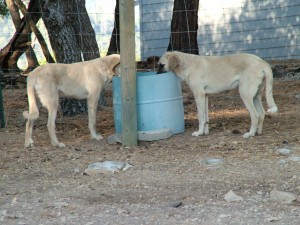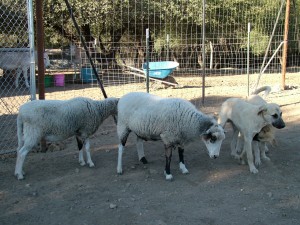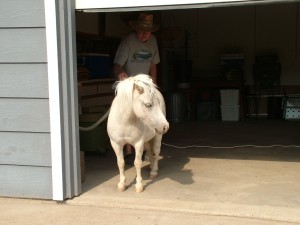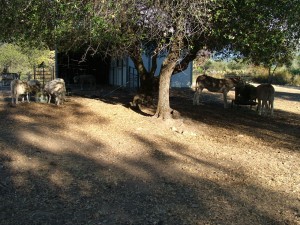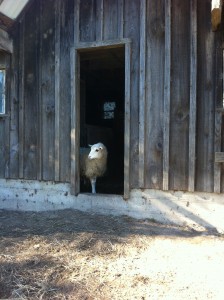-
Archives
- March 2025
- September 2023
- October 2022
- November 2020
- November 2019
- June 2019
- May 2018
- May 2017
- March 2017
- December 2016
- August 2016
- April 2016
- March 2016
- December 2015
- October 2015
- July 2015
- June 2015
- April 2015
- December 2014
- October 2014
- September 2014
- May 2014
- March 2014
- January 2014
- December 2013
- September 2013
- April 2013
- January 2013
- August 2012
- July 2012
- June 2012
- May 2012
- April 2012
- March 2012
- February 2012
- January 2012
-
Meta
A Return to Peace
The Ring of Protection is complete! That is what I’m calling the new security fence around the barn that allows the animals to spend the night outdoors rather than shut into stalls to protect them from predators, namely, mountain lions.
The guardian dogs, Daisy and Merlion, provide another ring of protection, day and night. When the fence was complete, the dogs were still too little to be safely in with the donkeys, so they spent the night in one section with the sheep and miniature horses, while the donkeys were in the other area. Now, everyone is together every night and getting along beautifully.
It has been fascinating to watch the animals establish their relationships. Each relationship is different, just as it is with people. As one example, the ewes Fleur and Snowflake rammed the dogs frequently at the beginning. Beau did little of this and bonded with the dogs immediately. I wondered why the ewes were doing this, but now that the dogs are almost full grown and larger than the ewes, I see that Fleur and Snowflake were wise in setting their boundaries so the dogs would respect their space and not jump all over them. The dogs got the message and peace reigns.
I know we have arrived at a new level of harmony because a few mornings ago when I came out to open the gates and give everyone breakfast, Snowflake was in the dog area with Merlion (the dog area is a small fenced place with a chain across an opening to keep the other animals out, giving the dogs a lair that they can retreat to if they like). Merlion came to greet me and Snowflake ducked under the chain to come out, just like he did.
Now that the fence around the garden is also complete, everyone is together all day long as well as all night. Before that, I couldn’t let the donkeys come into the area around the house where the garden is because there would have been no plants left. As it was, the sheep did some serious pruning, and the fence went up just in time to save the poor struggling plants.
Now everyone has their safe area, including the birds because the garden fence is cat-proof. I did that on purpose to give the birds their protected aviary—many finches, hummingbirds, sparrows, and woodpeckers, although the woodpeckers can most often be seen on the post by the water trough in the animal area, hanging upside down to take a drink. What acrobats they are!
Toward evening feeding time, the donkeys, horses, and sheep come to stand in front of my office window, letting me know it’s time to stop work.
If I’ve left the garage door open, Perseus enters and starts rooting in the recycling bin, tossing plastic bottles around the garage. The racket he makes usually suffices to get me out there, laughing at his creative antics.
It is a sheer pleasure to live so closely with the animals—to come out the front door to find the three donkeys standing there, waiting for a visit from me; to hear the donkey and horse calls throughout the day as I’m writing; to walk outside and have Beau joyously bound across the yard to greet me; to have the whole flerd (flock and herd) escort all visitors to my door; to look up from my computer to see one of the animals running across the yard in front of my window, in pure fun and joy; to wake up in the morning to the animals’ snuffling sounds in the Ring of Protection, knowing they are all safe and ready for the day.
Guardian Puppies
I was not expecting the next arrivals on the sanctuary to be dogs, but the killing of Aurora the sheep by a mountain lion brought about this event. Nor would I have thought I’d ever have outdoor dogs (dogs share houses!), but the tragedy called for some new thinking. It turns out many people up here in the foothills have guardian dogs to protect their sheep and goats, and to do the job right the dogs need to live with their charges. Daisy and Merlion, who are from the same litter, are a Great Pyrenees/Anatolian shepherd cross, two of the most common livestock guardian breeds.
I was struck from the first by how positive they are. They go happily through their days, taking all the changes in stride. On the ride home from the ranch where they were born, just a few miles from me, they were a little nervous at first, but then Daisy put her paws
on my shoulder and tucked her head into my neck, and all was well. I drove with one arm around her, marveling at this rapid bonding. When I got out of the truck to open the gate at home, they stood on the seat, wagging their tails. No sooner were they out of the truck, then they were trotting along at my heels. Clearly, they didn’t need to learn that I was their person!
Daisy’s name arrived long before she did. On the day after the mountain lion tragedy, I was standing in the porch area of the barn, putting dinner hay in the feeder for the donkeys. I had just decided that I would get a guardian dog. Suddenly, the name “Daisy” came into my head, almost like a physical flash. Sylphide, who was standing in front of me, startled backward, as though she had seen the flash. I laughed and said, “Yes, isn’t it amazing, Sylphide? We’re getting a dog and I think her name is Daisy.”
When I met the puppies at the ranch, two ran up to me immediately, the only black-faced ones in the group. I asked the one on the left, “Are you Daisy?”
I got a big yes, along with a beaming puppy smile. Her brother’s name did not emerge until a few days after they took up residence on the sanctuary. The name Merlion is a variation of Merlin that means “falcon”—I take it as a good sign that his name has “lion” in it too, both animal totem protection and acknowledgment that we (including mountain lions) are all connected.
I decided to get two instead of one from the eight-puppy litter (it was hard to leave the other six behind!) because Daisy and Merlion seemed to operate as a unit, Daisy was one of only two females in the litter and I wanted a female (figuring she would be more nurturing toward the sheep), I couldn’t imagine keeping one puppy on her own in the barn at night (which is what I was told to do to foster the dog’s bonding with the sheep), and I try to give everyone on the sanctuary a member of their own species as companion. I am so glad I got two, for all those reasons and also because I could never have met the puppies’ wrestling and playing needs!
After a week of encounters in various degrees of closeness, we are gradually settling into the new family arrangement (I’ve had to adjust too, with much animal juggling required). Now Merlion invites the horses to play by grabbing at their tails. So far they haven’t taken him up on his invitation, but I can imagine when he is full size that he and Perseus, who have similarly boisterous temperaments, will have grand romps together.
Beau is leading the sheep in investigating the dogs. Yesterday was an adjustment marker as Beau sniffed at the two puppies napping and they stayed stretched out and simply let him explore.
Daisy and Merlion will go a long way toward protecting the sheep from predators (I have told the donkeys the dogs will be their assistants, which seems to be assuaging their ambivalence about dogs as family members), but I am moving forward on having a 10-foot security fence installed around the barn so the animals don’t have to be shut in stalls at night. I am also clearing brush to remove possible hiding places. Meanwhile, Daisy and Merlion are growing up.
Posted in Dogs
Leave a comment
Aurora: In Memoriam
On March 11, a mountain lion killed our beloved sheep Aurora.
Weeks later, I am still in shock and grieving for her and what she must have had to go through. It happened during the night and I heard nothing. The mountain lion jumped one of the fences and I found Aurora’s body in the morning. It has taken me a while to be able to write this horrifying news. I had to gather my strength immediately, however, to figure out how to keep everybody else safe. For now, the sheep spend every night in one of the barn stalls, with Pegasus and Perseus the miniature horses in the other. Thank goodness for a well-built secure barn.
A door closes for one and opens for another. Everyone tells me the only way to keep the sheep safe is to get a guardian dog. I already have my name in for a puppy who comes from a long line of livestock guardians. So the next member of the sanctuary will be, unexpectedly, a dog. Cows are said to act as a deterrent as well. But before I welcome any more new members, I’ve got to have tall fencing built around the barn to provide a secure outdoor area.
This has been a hard lesson in sharing habitat, but I was glad to see when I googled how to protect livestock from mountain lions that the first page listed was the Mountain Lion Foundation. The lions need protection too. The foundation urges people who have sheep or goats to take responsibility to safeguard their animals so mountain lions are not drawn in. I’m working on it.
Sanctuary life is most often joyful, but there are times when it is so very painful. I take comfort in knowing, dearest Aurora, my little northern lights sheep, that you will light up our hearts forever.
Posted in Sheep
Leave a comment
Perseus and Pegasus: The Real Legends
A friend wondered why I would name the newest arrival to the sanctuary after “an antifeminist hero”—Perseus. Others of you might be thinking the same, so here is the real story of Pegasus and Perseus, along with a few other legendary lions.
Most people assume that the history of the winged horse Pegasus began with the Greek myth that made her famous. In actuality, Pegasus figures in human history from its very beginning.
The Greek myth got much of her story wrong and buried the truth of the rest of it in symbolism, obscuring it to all but the few who read the language of symbols. In the myth, Pegasus is born when “he” springs from the body (or blood) of the slain Medusa, who was beheaded by the Greek hero Perseus. That the mythmakers chose to render Pegasus masculine reflected the bias of the times toward male heroes and also the attempt to erase the heritage of the Goddess.
The Perseus myth tells us that Medusa was a Gorgon, a fearsome she-devil type, with snakes for hair, whose face would turn you to stone if you looked upon it. In the legend, Perseus is able to defeat Medusa by using a mirror so as to avoid looking directly at her. The mythmakers hid a grain of truth in the snakes they gave Medusa in place of hair. This detail provides a clue, perhaps unwittingly or perhaps as a snide joke, as to who she actually was—not a Gorgon, but a Libyan serpent-goddess. Though the myth depicts the snakes as fearsome and loathsome, serpents in ancient times were not objects of fear and disgust but were (and still are) synonymous with one’s inner wisdom, as many people have pointed out in deconstructing the Garden of Eden story, which gave both women and snakes such a bad name.
As for people turning to stone when they looked at Medusa, here is another grain of truth. What it symbolizes is that if you deny your inner wisdom, you disconnect from your soul and feel like stone inside. Or said another way, if you do not face your shadow within, it takes on huge and fearsome proportions and you think you will die if you turn inward and look at it. In truth, it is in not looking at Medusa that you are turned to stone. When you fully face your shadow and connect to your soul, you release the winged horse of creativity. So there is another grain of truth: Pegasus arising from the faced shadow. In actuality, she was there all along, reminding humans to look within instead of turning to stone, which is what all the Animal Messengers do. It is only when humans are brave enough to do that, however, that they are able to see the winged horse.
As for Pegasus’s birth, it had nothing to do with Medusa. Pegasus is actually the daughter of the great Earth goddess Demeter, which makes Demeter’s other daughter, Persephone, her sister. Persephone, whose name means “she who shines in the dark,” was the maiden goddess who descended to the Underworld and returned to tell about it. Now she goes back every year to keep in touch with the wisdom of the dark, or you could say, to keep her spiritual wits sharpened.
Pegasus’s pre-Greek name was Aganippe, which means Night Mare (note, mare!), a mare who visits dreamers in the night to impart her wisdom. The origin of the name “Pegasus” was either the sacred spring Pega or the Pegae, water-priestesses who tended sacred springs throughout the ancient world. It doesn’t matter which because in ancient days the springs and those who tended them were one, as humans and all of nature were, so each and both are the source of her name.
In those days, certain power-hungry humans rewrote the legends and myths in an attempt to separate people from nature and the divine feminine because people separated from their source are easier to control. The rewriting of Pegasus’s birth to have her rising from violence instead of nature and the divine feminine is an instance of this. The few grains of truth in the rewrites helped create confusion during the transition from the old to the new world order, and increased the odds of eventual acceptance of the revisionist history.
As I mentioned, Pegasus was around long before the Medusa myth began to be circulated in Athenian society. In fact, winged horses were featured in the art of ancient Persia, Mede, and Babylonia, thousands of years before the so-called Golden Age of Greece, which the modern Western world adopted as its foundation. The Golden Age featured the rewriting of many ancient myths. It was a violent time as certain factions strove to erase the history of harmony—hardly a golden age.
In her Greek period, Pegasus made her home with the Muses, all nine of them, on Mount Helicon (the Greek mythmakers retained this fact), which is between Delphi and Athens. One of the stories circulated about her in those days was that riding her was a way to become a great poet. Many aspiring poets took this literally and Pegasus was plagued by young men and women trying to climb onto her back. She always tossed them off, though never to their deaths, as the legend was embroidered for effect. Pegasus may have fumed to the Muses about the obtuseness of the poet manqués who followed her about. Perhaps Erato, the Muse of Poetry, attempted to instruct some of the poor aspirants on the concept of metaphor, a vital ingredient of poetry. “Riding Pegasus is a metaphor for the raptures of creativity,” I imagine her explaining to her bemused audience, and then dismissing them in annoyance when they looked at her blankly: “Go home and write, instead of chasing Pegasus.”
More grains of truth can be found in another installment of the Greek Pegasus myth in which the young warrior Bellerophon uses Pegasus for an attack by air on the monster Chimaera, like Medusa a supposedly fearful entity. Myth holds that after the slaying of the Chimaera and subsequent victories, Bellerophon’s achievements went to his head and he tried to use Pegasus to fly into heaven, but fell from her back and ended up blind and lame.
Reading the language of symbols, we discover that, like Medusa, the Chimaera was no monster. The truth can be found in what the word “chimera” has come to mean: “a utopian or unrealizable dream.” The mythmakers had Bellerophon slay the Chimaera as part of their campaign to train humans to think that “utopia” and “unrealizable dream” are one and the same. Believing that, the average man and woman in the street would stop embracing and manifesting their visions. The myth warned them that it is dangerous to aim too high. Bellerophon actually “fell” from his soaring into heaven because he denied the truth of the utopian vision and turned his back on his inner knowing. There was nothing Pegasus could do. As with all those who deny their truth, Bellerophon ended up “crippled” and unable to “see.”
In our current Age of Aquarius, we are leaving behind the age of “power over” and embracing partnership, the age of the heart. In this age, Perseus has the courage to face his own shadow, take responsibility for the inner wounding that impels him toward violence, and adopt a new way of relating to beings around him. Thus the gentle, affectionate horse who is the newest member of the Animal Messenger Sanctuary presents a model of the age of the heart: a loving way for he’s and she’s to be with each other, a demonstration of the healing of the male-female relationship, a revival of the original myths, and a reclamation of the name of Perseus as a noble one. And what a resonant sound: Pegasus and Perseus!
© 2014, by Stephanie Marohn, All rights reserved
Posted in Horses
Leave a comment
Remembering Chloe
Since the passing of our beloved Chloe, I have visited her grave every morning, after first selecting the perfect small stone for the day. This I place on one of the rocks that serve as her headstone, greeting Chloe as I do and telling her I miss her or sharing whatever I am moved to say to her at that moment. It is a comforting ritual that I have practiced with other departed ones. For me, the comfort of placing the stone comes partly from my connection to the Stone People, as nurtured by Native American sweat lodge teachings, and partly, I think, from the archetypal power of the ritual to offer comfort, as it has long done in the Jewish tradition and now it seems is doing so for non-Jews as well (U.S. cemeteries report a growing trend of visitors leaving stones on graves regardless of religious affiliation).
Why leave a stone? Explanations for the ritual vary: The stone signals that someone remembers the one who died. The stone tells us that love lasts forever, like stone. It symbolizes the eternal nature of divine love, which sustains and blesses both the mourner and the soul of the departed one. It symbolizes the building of a monument to the deceased. I like to think of the stone as representing the soul-to-soul connection between the departed one and the one who places the stone.
Chloe, you are dearly remembered and I feel your glowing queenly soul touching mine. Thank you for gracing us with your presence. Love from Stephanie and the flock.
© 2014, by Stephanie Marohn, All rights reserved
Posted in Sheep
Leave a comment
Pegasus Gets a Twin
A gift just arrived to the sanctuary, and especially to Pegasus. I had promised her that when we got to our new home, I would find her a horse friend her size. She likes her herd (the three donkeys and the five sheep), but a spark has been missing in her since her beloved donkey soul mate, Gabriel, died. On December 1, I saw that spark return.
In the usual synchrony of arrivals to the sanctuary, Pegasus was sent the perfect companion. It was love at first sight. She squealed wildly when this miniature white horse that looks just like her (aside from blue eyes instead of black) walked up to her, and she continued squealing all that day and into the night.
From that first moment, they have not left each other’s sides. The morning after he arrived, I had to close a stall door between them to give Pegasus her mash. They both got upset, her squealing and him pawing the ground. I opened the door enough for them to see each other, and they touched noses. Having reassured themselves that they were not to be separated, they both went back to eating their breakfast. (I’m not referring to our newest animal messenger by name because I’m waiting for his name to arrive.)
Pegasus is clearly ecstatic, and this new energy is turning her into a young horse
again. Thank you, Universe, for sending Pegasus another soul mate.
Meanwhile, the other animals have adjusted to the new arrival. It was amazing to witness the flurry of activity that greeted his entrance. The donkeys, the sheep, and the new horse took off running–all around the property. It didn’t appear that anyone was chasing anyone. They were all just running. And there was Chloe the elder arthritic sheep running with them! I hadn’t seen her move like that in quite a while and presumed she would be sore the next day, but she was fine. It seems everyone has gotten a new lease on life!
Pegasus didn’t join in this initial gallop. She was enjoying her dinner and appeared not to have noticed the newcomer. You would think she would wonder what all the running was about, but she placidly chewed on until the little horse stopped his running and walked up to her. Perhaps he had just noticed her too. The connection was immediate and electric–Pegasus doing all that squealing, along with stamping a front foot, then turning around to kick up her heels at him. She could have connected those kicks if she wanted, but she kicked the air in front of his face instead. He stayed right with her throughout this display and then they went off together, him exploring the property and her squealing. At first I thought the squealing was a display of dominance, letting him know who was in charge. There may have been some of that, but it soon became clear that the squeals were utter attraction and invitation. The only other time I’ve heard her squeal like that was when she first came to my place and met the full-size gelding living there. She let out that high-pitched squeal, dancing in front of the gelding. His companion, a full-size mare, promptly bit Pegasus on the head–back off!
Now it’s a frosty morning in the foothills and I am blessed by the sudden sight of Pegasus and her new soul mate walking by in front of my writing studio window. They want their breakfast and I am late getting out to the barn.
A final note: I missed the chance to photograph the twins in all their white-coated glory, for now anyway. On arrival day, both were glowingly white, but that night it rained and they clearly enjoyed rolling in the wet dirt. I may not get a chance for a while to capture their fluffy white coats (let’s hope so–we need the rain).
Posted in Donkeys, Horses, Sheep
Leave a comment
Home at Last
The animals and I have arrived at our forever sanctuary in Sheep Ranch, California! And it is truly wonderful.
As it turned out, I drove the truck pulling the horse trailer with all the animals in it to get us here. (Thanks to Kimberly Carlisle of the Flag Foundation for lending the rig and to Mary Marohn and Lewis Griggs for helping persuade Ulysses to join us!) This was after a longer loading process than I had anticipated. Ulysses (still a young donkey) absolutely refused to get in, even when all the others were standing in there looking out at him. I had given him over a month to get used to the trailer, but no…Chloe thought he had the right idea, however, and kept coming out of the trailer to join him. Eventually, we had to resort to pushing and pulling. When he finally put his feet on the floor mats of the trailer, he lay down, seemingly overwhelmed by the whole experience. He soon stood up and joined the others though. The trip took 5 hours at trailer speed. I stopped and checked on the animals a few times on the way, and they were standing calmly side-by-side. Seeing them like that, instead of sweating and wide-eyed in anxiety, as they had been at the start, reassured me and I began to relax too. I definitely had to cowgirl-up to do this drive. I did it!
When I had gotten the trailer into position, backed up to one of the pasture gates at the new place (no easy feat), I could hardly wait to open the back door and let the animals out to see their new home. This was the moment I had looked forward to the whole drive, and long before that. When I pulled open the heavy trailer door, I was horrified to see Chloe down. Even as I rushed to her aid, I noticed how the other animals were standing respectfully back to keep from stepping on her. Worried this elder sheep had collapsed from exhaustion, heart attack, or some other malady, I soon discovered that it was simply that she couldn’t get her footing on the slippery floor to get back up again (a reminder to use wood shavings when trailering). I helped her up and out of the trailer. The other animals followed, save Ulysses who again hesitated at the transition required. It comes to me now that he doesn’t completely trust his footing because he was born with weak back feet. As always, the animals have their reasons. After his brief hesitation, Ulysses leapt out, joined the others, and we were all home!
I fed and watered them immediately. They ate and drank and then took a walk. Traveling in a loose line, they all went together to investigate their territory. They walked slowly through the series of pastures that run in a U shape around my house, taking it all in. When they got to the woods, they turned around and came back to where I’d placed their feeder under a big oak tree next to the barn. That was enough investigation for the day. They stayed close to the barn for the rest of the evening—home base already.
When I looked out a little later, Chloe was lying at the base of twin oaks on the other side of the barn from the feeder. With head up, she was serenely regarding the world around her. Since then, she is often to be found lying in that same spot. I think of it already as Chloe’s tree. It made me happy that she found her peaceful place at our new home so quickly.
My circle calls this place the House the Goddess Built. And it truly is. More and many thanks to everyone who helped us get here.
Calling All Angels
Dear Friends,
The animal sanctuary and I need a new home. The place where we’ve been living has just been sold and we need to move by the end of July. My sanctuary has a nonprofit sponsor and I am a writer of body-mind-spirit books, so you will be supporting two good causes when you help us find a new home! We would like to stay in western Sonoma-Marin counties if possible but are open to all locations. Our ideal is a small farm/ranch, no less than 10 acres, a standalone rural property with dwelling for me, and a barn/shelter and fenced acreage for 3 donkeys, a miniature horse, and 5 sheep (all rescues). Considering all creative solutions: rent, caretake, rent to own, buy. Please spread the word. Thank you so much for helping us arrive at our new home.
See my website for info about the sanctuary and me. All the best, Stephanie
Posted in Sheep
Leave a comment
The Holy Fool
Rumi says, “Start a huge, foolish project, like Noah.”
The Fool card in Tarot signifies having no fear.
The Holy Fool is the one who is “foolishly” fearless.
Angeles Arrien talks of how calling someone foolish is really criticism of risk-taking behavior.
One definition of courage is going forward even in the face of fear.
Friends once gave me a paperweight inscribed with the question: what would you attempt to do if you knew you could not fail?
Think about all of this when next you tell yourself you are crazy for trying to live out a large vision. I do!
Posted in Uncategorized
Leave a comment


